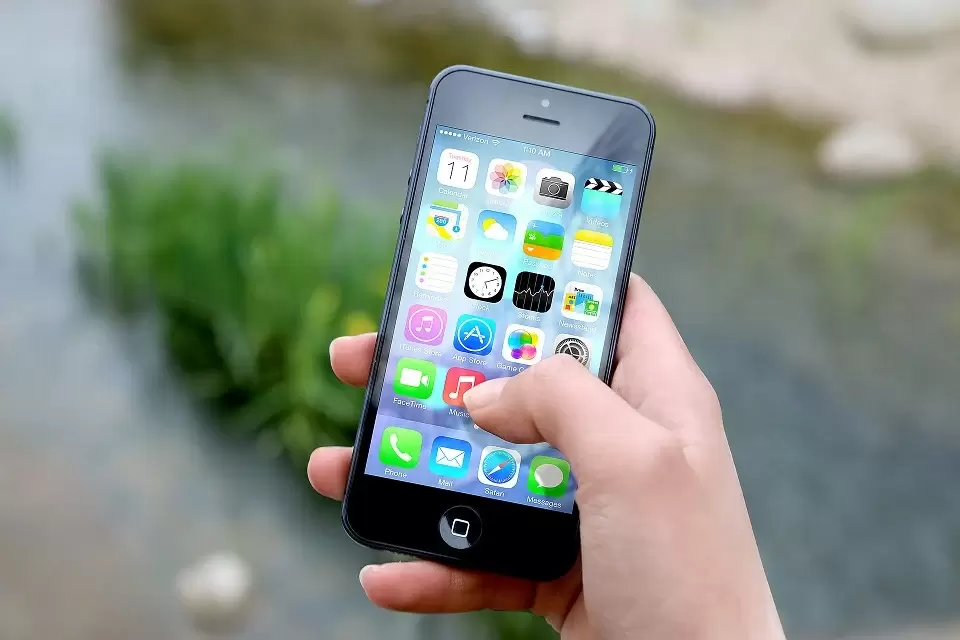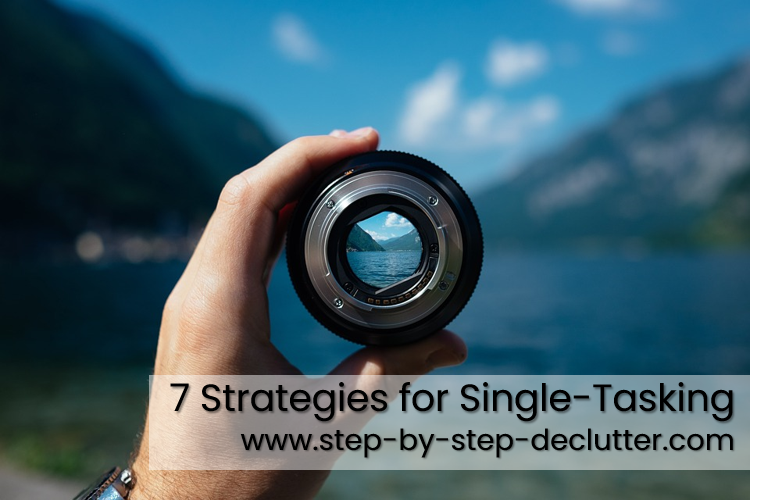|
|
7 Strategies for Single-Tasking |
|
What if I told you that single-tasking not only makes you more productive but also helps you retain your decision-making capacity later in life? It's true! A study conducted by the MetLife Mature Market Institute found that those with a high capacity for strategic attention (the ability to focus) were better decision makers. What's more, these skills seemed to improve with age.
I've talked before about the negative affects of multitasking on brain function. The good news is the brain responds well to neuron-building cognitive practices in much the same way as the body responds to physical exercise by growing stronger and becoming more flexible. One excellent brain practice you can employ for prolonged brain health is single-tasking.
Simply put, single-tasking is the process of minimizing distractions in order to focus on a single task (hence the name) and see it through to completion. The concept is simple enough, but in today's world of near constant distractions, it takes a concerted effort to single-task effectively. The good news is there are strategies we can employ to improve our ability to single-task in a world fixated on multitasking.
I've talked before about the negative affects of multitasking on brain function. The good news is the brain responds well to neuron-building cognitive practices in much the same way as the body responds to physical exercise by growing stronger and becoming more flexible. One excellent brain practice you can employ for prolonged brain health is single-tasking.
Simply put, single-tasking is the process of minimizing distractions in order to focus on a single task (hence the name) and see it through to completion. The concept is simple enough, but in today's world of near constant distractions, it takes a concerted effort to single-task effectively. The good news is there are strategies we can employ to improve our ability to single-task in a world fixated on multitasking.
|
|
Cell Phones: Devices of Distraction |
|
How many times a day do you touch your cell phone? The number might just startle you. A research firm called Dscout conducted a study of 94 Android users. They loaded an app on volunteers smart phones which measured the number of times the screen was touched in a 24 hour period. The result was 2,617 strokes of the screen for the average cell phone user! Breaking it down in another way, cell phones uses typically spent 145 minutes a day on their phones. That's nearly 2 1/2 hours. Granted, cell phones do offer plenty of value in terms of their usefulness, but I know in my case, at least, much of the time I spend interacting with my phone could be spent more productively in some other pursuit.
Disable Distractions |
|
It probably comes as no surprise that one of the best strategies for successful single-tasking is to limit distractions. While electronics are a major source of distraction, they are by no means the only saboteurs of concentration. If you're looking to limit mental diversions, start by employing the following tactics:
- Disable notifications - The whole purpose of notifications is to get your attention. They can easily be disabled in your phone's settings, allowing you to decide when to check various apps for information and updates.
- Avoid social media - Nothing is more subtle or effective in its ability to devour huge swaths of time than social media. Fortunately, there are numerous apps available to help you control your social media use in order to focus more effectively and be more productive.
- Keep your email closed - Email is a necessary evil, but it doesn't have to monopolize your time. Set a specific time to check email, perhaps twice a day, and keep it closed the rest of the time.
- Remove physical clutter - Believe it or not, disorder can be a source of distraction. Whether or not you realize it, a messy environment messes with the brain's ability to focus. To the brain, clutter reads as undone tasks, and thinking about those undone tasks (even subconsciously) can serve as a drain on productivity.
- Eliminate digital clutter - Keep your computer desktop orderly. Organize saved documents in a sensible manner that makes them easy to retrieve. Reduce the number of tabs you have open in your browser window. All of these things serve as distractions and negatively impact one's ability to hone in on what's important.
- Turn off your cell phone (or leave it in another room) - If you’re really serious about concentrating, it’s best to turn off your device entirely. Even if you’re not actively using an electronic devise, research indicates that the device can still serve as a distraction. In particular, studies suggest that having a device in your vicinity where you can hear it ding, buzz, or vibrate is a source of distraction, even if you don’t respond. When my phone gets a text or email the screen lights up. If it's sitting on my desk, I can see it light up out of the corner of my eye (even if I have it flipped over). That flash of illumination zaps my concentration. While the distraction may only last a brief moment, getting back in the groove can take as much as 15 minutes according to psychologist, author, and science journalist Daniel Goleman in his book Focus: The Hidden Driver of Excellence (affiliate link):.
Focus on One Task at a Time |
|
I think this quote from Charles Dickens' novel Dombey and Son sums up this strategy nicely: "He did each single thing as if he did nothing else."
Attention diminishing temptations abound. It's difficult to use the internet without getting distracted. Ads pop up periodically or appear in the margin of the page, Google searches yield a plethora of possibilities that must be sifted through and analyzed for their relevance. One thing gets you thinking about another. Before you know it, you can easily have a dozen tabs open on your browser, each representing an investment in time.
To single-task successfully requires commitment to one task at a time. It takes practice. Most of us aren't used to doing it. It can be challenging at first, but ultimately focusing on just one thing at a time increases productivity and reduces stress. When we focus on only one task at a time we allow our brains to get into what's known as a flow state where ideas flourish and creativity thrives.
Attention diminishing temptations abound. It's difficult to use the internet without getting distracted. Ads pop up periodically or appear in the margin of the page, Google searches yield a plethora of possibilities that must be sifted through and analyzed for their relevance. One thing gets you thinking about another. Before you know it, you can easily have a dozen tabs open on your browser, each representing an investment in time.
To single-task successfully requires commitment to one task at a time. It takes practice. Most of us aren't used to doing it. It can be challenging at first, but ultimately focusing on just one thing at a time increases productivity and reduces stress. When we focus on only one task at a time we allow our brains to get into what's known as a flow state where ideas flourish and creativity thrives.
|
|
The Rhythm of Focus |
|
My husband and I recently discovered a service called brain.fm. We've been using it for several months, and I'm a big fan. I'm normally opposed to listening to music while working. I find it distracting. The music on brain.fm isn't music in the traditional sense. It isn't meant to entertain. There's a real pulsating nature to it. It's based on brain research and utilizes something called Dynamic Attending Theory.
I'm not an affiliate. I'm just a satisfied customer. It takes a few minutes to get into a mental groove, but once there I find that I can really hone in on my writing or whatever I'm working on and block out external distractions (like my husband listening to a podcast in the next room). For me it works best when wearing noise cancelling headphones, and yes, I'm listening right now!
I'm not an affiliate. I'm just a satisfied customer. It takes a few minutes to get into a mental groove, but once there I find that I can really hone in on my writing or whatever I'm working on and block out external distractions (like my husband listening to a podcast in the next room). For me it works best when wearing noise cancelling headphones, and yes, I'm listening right now!
Narrow Down Your Task List |
|
It's difficult to single-task if you feel overwhelmed by the length of your to do list. Learning to prioritize and limit tasks is very helpful in becoming a successful single-tasker. A good place to start is with a Master Task List. I like to categorize mine according to the type of task. For instance, I have a list of household tasks, a list of work tasks, a list of family-related tasks, and so forth.
Once you have a task list, take a few minutes to prioritize the items on the list. Those with the highest priority become your Most Important Tasks (MIT). Each day, choose 1-3 tasks from your MIT list to focus on. Leo Babauta's article Unprocrastination: The Art of Choosing Important Tasks (zenhabits.net) offers a good starting place for learning to prioritize tasks.
Once you have a task list, take a few minutes to prioritize the items on the list. Those with the highest priority become your Most Important Tasks (MIT). Each day, choose 1-3 tasks from your MIT list to focus on. Leo Babauta's article Unprocrastination: The Art of Choosing Important Tasks (zenhabits.net) offers a good starting place for learning to prioritize tasks.
Learn to "Eat the Frog" |
|
|
"If it's your job to eat a frog, it's best to do it first thing in the morning. And if it's your job to eat two frogs, it's best to eat the biggest one first." ~ Mark Twain
This bizarre statement refers to doing the most distasteful task first. Whatever it is that is hardest for you or that you like least should be the thing you tackle first (if at all possible). |
Work in Batches |
|
Grouping like tasks together is a great way to consolidate your effort. Instead of answering emails as they appear in your inbox, set aside a specific time for handling correspondence. If you are waiting on incoming information to complete a task, check email in between other tasks after seeing them through. Use this strategy for paying bills, writing, making phone calls, or whatever other related tasks you might have on your to do list. Each group of tasks requires a specific mindset. Grouping like tasks together allows you to get into the groove mentally and then stay there until the task is complete.
Engage in the Mindful Use of Electronics |
|
Mindful use of electronics begins with increasing your awareness of your personal patterns of usage. Start by making a mental note regarding how you're using your device, when, and for how long. Your phone will actually tell you how much and how you've used it over the course of a week. Also notice when you feel compelled to pull away from an activity and what it is that distracts you. Use this information to help you disable your distractions and adjust your behavior.
Consider scheduling digital Sabbaths or intentional breaks from connectivity. Go for a walk and leave your phone at home. Read a book, visit a friend, play a game, do a puzzle, meditate - without your phone nearby. We used to go from one place to another without immediate access to a telephone without thought or concern. Now we feel almost naked when we realize we've walked out of the house without our cell phones. Spending intentional time disconnected from a device can help us to become comfortable with living in the moment and enjoying the experience.
Consider scheduling digital Sabbaths or intentional breaks from connectivity. Go for a walk and leave your phone at home. Read a book, visit a friend, play a game, do a puzzle, meditate - without your phone nearby. We used to go from one place to another without immediate access to a telephone without thought or concern. Now we feel almost naked when we realize we've walked out of the house without our cell phones. Spending intentional time disconnected from a device can help us to become comfortable with living in the moment and enjoying the experience.
Work With Your Brain |
|
The human brain has a natural pattern of attentiveness and relaxation. In order to maximize output it's best to honor those peaks and valleys by balancing concentration with relaxation. You can give your brain the downtime it needs by consciously creating pauses throughout the day.
The sweet spot appears to be 52 minutes on with 17 minutes off. It sounds random, I know, but it's based on data analyzed by the productivity app DeskTime whose makers looked at the habits of its most productive uses. The key to taking a successful break is to step away from the computer and other electronics. The best results come from giving your brain a total recess by taking a walk, doing some stretching, talking to someone, or engaging in some other mentally rejuvenating activity. You can read more about this fascinating phenomenon here and here.
You've probably noticed this process in your own life. Have you ever wondered why the best ideas seem to come to the surface when you’re doing something that requires very little mental effort such as driving, taking a shower, or falling asleep at night? It's because doing mundane tasks affords your brain the down time it needs to process information.
The sweet spot appears to be 52 minutes on with 17 minutes off. It sounds random, I know, but it's based on data analyzed by the productivity app DeskTime whose makers looked at the habits of its most productive uses. The key to taking a successful break is to step away from the computer and other electronics. The best results come from giving your brain a total recess by taking a walk, doing some stretching, talking to someone, or engaging in some other mentally rejuvenating activity. You can read more about this fascinating phenomenon here and here.
You've probably noticed this process in your own life. Have you ever wondered why the best ideas seem to come to the surface when you’re doing something that requires very little mental effort such as driving, taking a shower, or falling asleep at night? It's because doing mundane tasks affords your brain the down time it needs to process information.
There you have it - 7 strategies for single-tasking. I'm not going to pretend that I'm perfect at this process, but I can tell you that these strategies are effective at improving one's focus, and thereby one's productivity. I feel better and get more done when I earnestly strive to eliminate distractions and utilize downtime.
I hope you will have success as you strive to implement these strategies in your life as well.
I hope you will have success as you strive to implement these strategies in your life as well.
Proudly powered by Weebly




